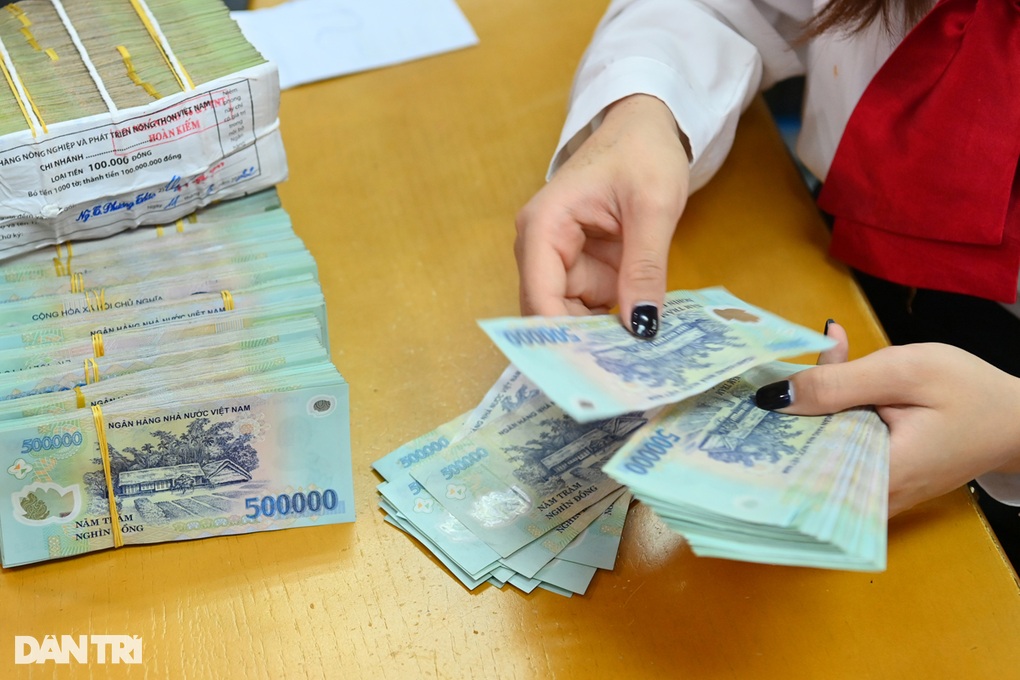According to the latest data released by the State Bank, people's deposits at credit institutions by the end of February reached 7,366 trillion VND, up 4.26% compared to the end of 2024, setting a new record. Compared to the end of January, people's savings deposits increased by 178 trillion VND and compared to the end of 2024, they increased by 301 trillion VND.
At the same time, deposits of economic organizations continued to decrease for the second consecutive month. Specifically, the amount of deposits of economic organizations decreased by 71,000 billion VND in February, bringing the decrease in the first two months of the year to 305,000 billion VND. Economic organizations currently deposit money at banks with 7,362 million billion VND, down 3.98% compared to the end of 2024.
Thus, the amount of deposits in the banking system of individual customers has officially exceeded the deposits of economic organizations.

People's deposits in banks increased sharply (Photo: Tien Tuan).
To attract capital from the population, in February, many banks increased their deposit interest rates. Many banks raised their deposit interest rates above 6%/year, higher than the average level in many previous months. The 3-month deposit interest rate ranges from 3.5-4.6%/year; 6-month deposit interest rate ranges from 4.8-5.9%/year; 12-month deposit interest rate ranges from 5.8-7.7%/year, depending on the bank.
However, since the end of February, the Government and the State Bank have asked commercial banks to reduce deposit interest rates to facilitate lower lending rates. From March to now, 29 banks have reduced deposit interest rates by 0.3-1.3% per year, depending on the term.
Dr. Chau Dinh Linh, lecturer at the Banking University of Ho Chi Minh City, said that the monetary policy orientation of the State Bank is to maintain low interest rates, supporting businesses and the economy after impacts such as the Covid-19 pandemic, typhoon Yagi and most recently global trade tensions. From there, banks have made appropriate adjustments to input interest rates.
Savings interest rates are currently uneven, depending on the product, term, and size of the bank. Larger banks have more liquidity, while smaller banks with liquidity pressure will have different interest rates.
According to experts, in general, current savings interest rates tend to be stable at a basic level, but medium and long-term interest rates tend to increase higher than short-term interest rates.
Traditional savings interest rates are not high, but still attract people's deposits due to safety and people's need to preserve capital.
Mr. Linh believes that many people consider savings as a temporary channel, waiting for other investment opportunities with higher profit potential to appear. However, according to him, this is still a safe investment channel in the context of other investment channels having high risks or not being attractive enough in terms of profit.
Source: https://dantri.com.vn/kinh-doanh/736-trieu-ty-dong-tien-gui-cua-nguoi-dan-chay-vao-ngan-hang-20250521100152150.htm





![[Photo] Cat Ba - Green island paradise](/_next/image?url=https%3A%2F%2Fvphoto.vietnam.vn%2Fthumb%2F1200x675%2Fvietnam%2Fresource%2FIMAGE%2F2025%2F12%2F04%2F1764821844074_ndo_br_1-dcbthienduongxanh638-jpg.webp&w=3840&q=75)


















































![[VIMC 40 days of lightning speed] Da Nang Port: Unity - Lightning speed - Breakthrough to the finish line](https://vphoto.vietnam.vn/thumb/402x226/vietnam/resource/IMAGE/2025/12/04/1764833540882_cdn_4-12-25.jpeg)















































Comment (0)